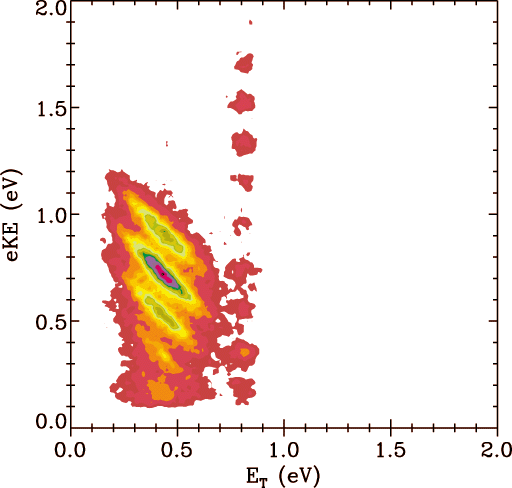Continetti Group
Research
Transient species, including reactive free radicals and molecular clusters, play central roles in governing the chemical behavior of complex systems. Broadly speaking, we seek to characterize these species by using a variety of techniques, including mass spectrometry, photoelectron and photofragment spectroscopies and the measurement of scattering cross-sections. These experiments provide critical tests of modern electronic structure and dynamics calculations, and in the case of three-body systems, new types of experimental data on the dynamics of these processes.
Our studies of reactive free-radicals, transition-states and three-body dissociation dynamics provide unique information using the photoelectron-photofragment coincidence technique developed in our laboratory. (1) These experiments are carried out using fast, mass-selected anion beams with short-pulse laser photodetachment. The photoelectron kinetic energies are measured using both time-of-flight and imaging photoelectron spectrometers. The photoelectron kinetic energy is measured, which determines the internal energy in the neutral molecule or cluster under study. If the neutral is unstable and dissociates, then the kinetic energy and angular distributions of the products are recorded using sophisticated time- and position-sensitive detectors. Analysis of these experiments is carried out in conjunction with ab initio electronic structure, Franck-Condon and dynamics calculations. Examples of these experiments are found in our papers on O4- and O3-. (2,3) We have also recently extended these studies to the transition-state dynamics of elementary hydroxyl radical reactions such as OH + H2O → H2O + OH. (4) With the recent development of a multiparticle detector, we are now extending this technique to three-body dissociation dynamics, as shown in our study of the three-body dissociation of O3(D2O) complexes. (5) Finally, we have carried out a number of photoelectron spectroscopy experiments on systems that do not dissociate, including CCO, C2H3O and SO3. (6) We are currently extending these studies to other organic radicals and sulfur-oxygen compounds.
A new project underway in the laboratory focuses on heterogeneous reactions of SO2 and NO2 with salt and graphite surfaces. These experiments are carried out on a molecular-beam surface scattering chamber, and seek to provide new insights into the heterogeneous processes that lead to the formation of H2SO4 and HNO3 in the atmosphere.
Finally, we have a mass spectrometer that is used to examine new approaches to the generation of anions, including laser-desorption and matrix-assisted-laser-desorption sources. We have carried out experiments on laser-desorption from cryogenic matrices (7) and have been exploring new methods for high-throughput analysis by mass spectrometry.

O4- photoelectron-photofragment correlation spectrum. The diagonal lines correspond to vibrational excitation in the O2 products.